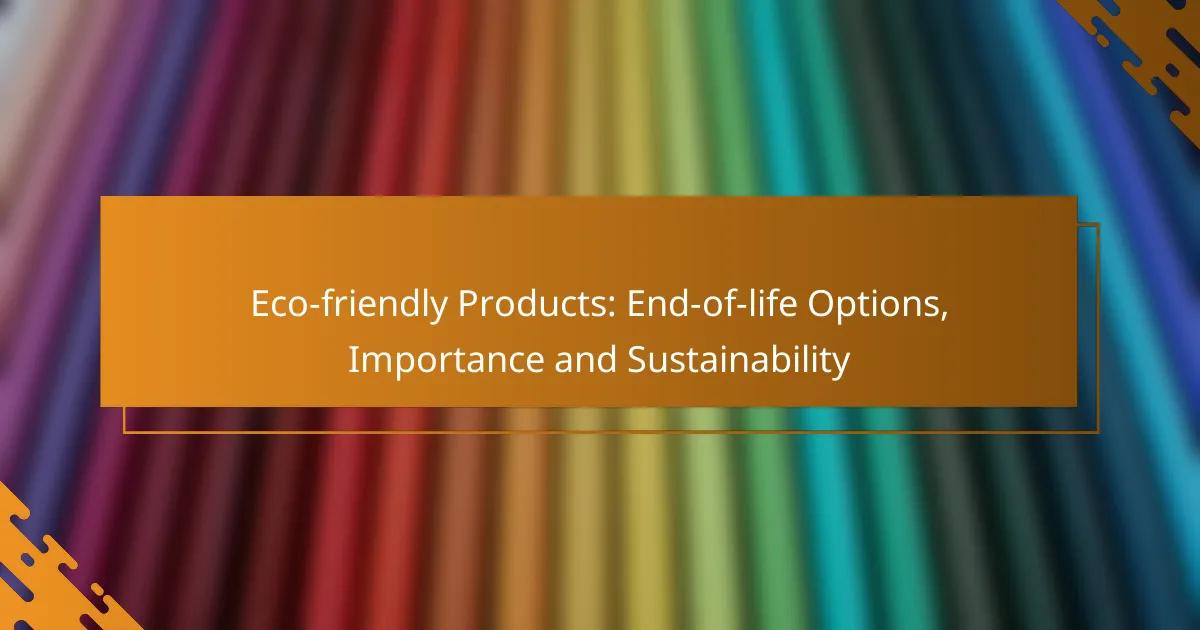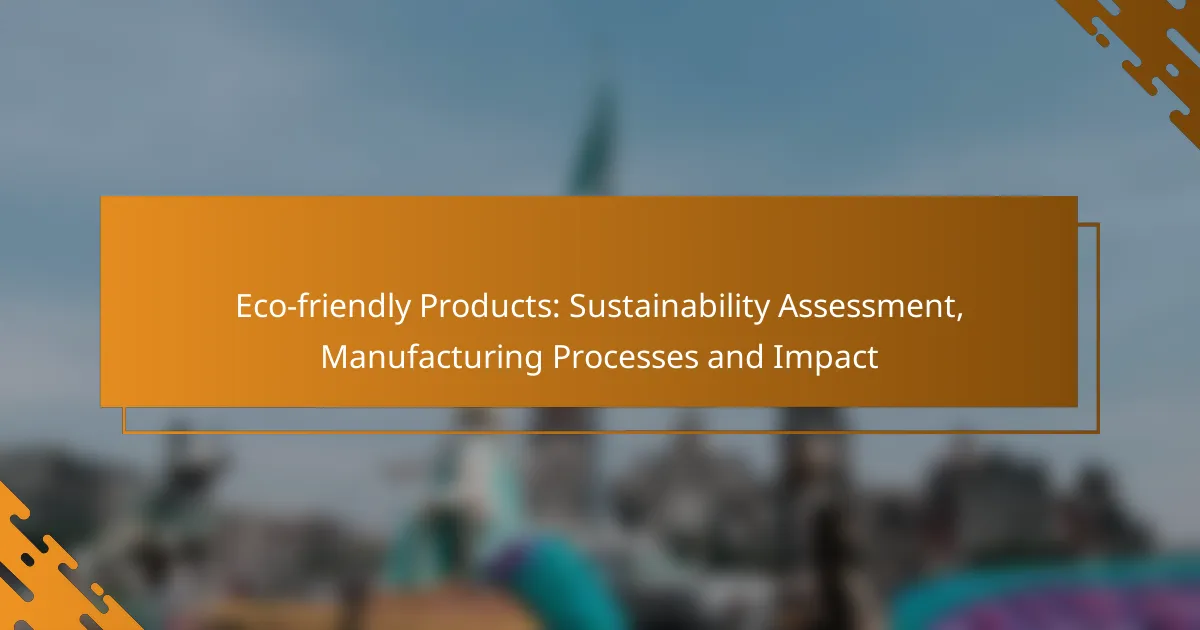Eco-friendly product end-of-life options are essential for minimizing environmental impact and promoting sustainability. By embracing methods such as recycling, composting, and upcycling, consumers can ensure that their discarded items are managed responsibly. Prioritizing sustainable practices not only supports a healthier planet but also encourages responsible resource use throughout the product lifecycle.

What are eco-friendly product end-of-life options?
Eco-friendly product end-of-life options refer to sustainable methods for disposing of or repurposing products once they are no longer usable. These options aim to minimize environmental impact by promoting recycling, composting, donating, upcycling, and exploring alternatives to traditional landfills.
Recycling programs
Recycling programs are structured systems that collect, process, and convert waste materials into new products. Many communities offer curbside recycling services, while others may require drop-off at designated centers. It’s essential to check local guidelines for accepted materials to ensure proper recycling.
Participating in recycling programs can significantly reduce landfill waste and conserve natural resources. For example, recycling paper can save trees and reduce energy consumption compared to producing new paper from raw materials.
Composting solutions
Composting solutions involve breaking down organic waste, such as food scraps and yard waste, into nutrient-rich soil. This process can be done at home or through municipal composting services. Home composting requires a balance of green materials (nitrogen-rich) and brown materials (carbon-rich) for optimal decomposition.
Composting not only diverts waste from landfills but also enriches soil, promoting healthier plant growth. Many communities offer compost bins or workshops to help residents start composting effectively.
Donation and resale
Donation and resale options allow individuals to give new life to unwanted items by passing them on to others. Many charities accept gently used products, while online platforms facilitate resale through marketplaces. This approach extends the life cycle of products and reduces waste.
Before donating or reselling, ensure items are clean and in good condition. Check local regulations regarding donation tax deductions, as these can vary by region.
Upcycling initiatives
Upcycling initiatives transform discarded items into new products of higher value or quality. This creative process can involve crafting furniture from pallets or turning glass jars into decorative storage. Upcycling not only reduces waste but also encourages creativity and resourcefulness.
Consider joining local workshops or online communities focused on upcycling to gain inspiration and learn new techniques. This practice can also save money while contributing to a more sustainable lifestyle.
Landfill alternatives
Landfill alternatives include various methods to manage waste without relying on traditional landfills. Options such as waste-to-energy facilities convert waste into energy through combustion, while anaerobic digestion processes organic waste to produce biogas.
Research local facilities that offer these alternatives, as they can significantly reduce the environmental impact of waste disposal. Engaging in community discussions about waste management can also promote awareness and encourage the adoption of sustainable practices.

Why is sustainability important for eco-friendly products?
Sustainability is crucial for eco-friendly products as it minimizes negative impacts on the environment while promoting responsible resource use. By prioritizing sustainable practices, consumers can contribute to a healthier planet and support long-term ecological balance.
Reduces environmental impact
Eco-friendly products are designed to have a lower environmental footprint compared to conventional alternatives. This reduction is achieved through sustainable sourcing, manufacturing processes, and end-of-life options that prioritize recycling or composting.
For example, biodegradable materials break down naturally, reducing landfill waste and pollution. Choosing products with minimal packaging or those made from recycled materials can further decrease environmental harm.
Conserves natural resources
Using eco-friendly products helps conserve natural resources by promoting the use of renewable materials and reducing reliance on finite resources. Sustainable practices, such as using plant-based materials, can significantly lessen the demand for non-renewable resources like fossil fuels.
For instance, products made from bamboo or recycled plastics often require less energy and water to produce compared to traditional materials. Consumers can look for certifications like FSC (Forest Stewardship Council) to ensure responsible sourcing.
Supports ethical consumerism
Choosing eco-friendly products aligns with ethical consumerism, which emphasizes purchasing goods that are produced responsibly and sustainably. This approach supports companies that prioritize environmental stewardship and fair labor practices.
By selecting products from brands committed to sustainability, consumers can drive demand for ethical practices in the marketplace. Engaging with local businesses that focus on sustainable production can also enhance community support and economic resilience.

How can consumers choose sustainable products?
Consumers can choose sustainable products by focusing on certifications, researching brand practices, and evaluating the product lifecycle. These steps help ensure that the products they buy are environmentally friendly and ethically produced.
Look for certifications
Certifications are key indicators of a product’s sustainability. Look for labels such as Energy Star, USDA Organic, or Fair Trade, which signify adherence to specific environmental and ethical standards. These certifications often require rigorous testing and compliance with established guidelines.
When shopping, prioritize products with recognized certifications relevant to your region, as they can vary by country. For instance, the EU Ecolabel is a trusted mark in Europe, while the Green Seal is recognized in the United States.
Research brand practices
Understanding a brand’s practices is essential for making informed choices. Investigate how companies source materials, their manufacturing processes, and their commitment to sustainability. Brands that are transparent about their supply chains and environmental impact are more likely to be genuinely sustainable.
Check for sustainability reports or third-party assessments that detail a brand’s environmental initiatives. Engaging with customer reviews and forums can also provide insights into a brand’s practices and reputation.
Evaluate product lifecycle
Assessing a product’s lifecycle involves examining its environmental impact from production to disposal. Consider factors such as the materials used, energy consumption during manufacturing, and end-of-life options like recyclability or biodegradability. Products designed with a circular economy in mind are preferable.
To make a practical evaluation, ask questions like: Is the packaging recyclable? Can the product be repaired or reused? Understanding these aspects can guide you toward products that minimize waste and promote sustainability.

What are the benefits of eco-friendly products?
Eco-friendly products offer numerous benefits, including improved health, long-term cost savings, and increased brand loyalty. By choosing sustainable options, consumers can positively impact their well-being and the environment while supporting businesses committed to sustainability.
Health advantages
Using eco-friendly products can lead to better health outcomes by reducing exposure to harmful chemicals found in conventional items. For instance, organic cleaning supplies often contain natural ingredients that are less likely to irritate skin or respiratory systems.
Additionally, eco-friendly products typically have lower levels of volatile organic compounds (VOCs), which can contribute to indoor air pollution. By opting for these alternatives, consumers can create a healthier living environment for themselves and their families.
Cost savings over time
While eco-friendly products may have a higher upfront cost, they often lead to significant savings in the long run. Durable items, such as reusable bags or stainless steel containers, can replace disposable options, reducing waste and the need for frequent purchases.
Moreover, energy-efficient appliances can lower utility bills by consuming less electricity or water. Over time, these savings can offset the initial investment, making eco-friendly choices financially beneficial.
Enhanced brand loyalty
Consumers are increasingly drawn to brands that prioritize sustainability, leading to enhanced brand loyalty. Companies that offer eco-friendly products often resonate with environmentally conscious customers who appreciate transparency and ethical practices.
By aligning with consumer values, businesses can foster long-term relationships and encourage repeat purchases. This loyalty not only benefits the brand but also promotes a broader shift towards sustainable consumption patterns in the market.

How do eco-friendly products impact local communities?
Eco-friendly products positively influence local communities by promoting sustainable practices and enhancing economic opportunities. These products often lead to job creation and increased awareness about environmental issues, fostering a culture of sustainability.
Job creation in green industries
Green industries, such as renewable energy, organic farming, and sustainable manufacturing, generate numerous job opportunities. For instance, solar panel installation and wind turbine maintenance are growing fields that require skilled labor, often providing competitive wages.
Additionally, local businesses that focus on eco-friendly products can stimulate the economy by creating jobs in retail, distribution, and service sectors. Communities that invest in green jobs often see a boost in overall employment rates and economic resilience.
Community awareness initiatives
Community awareness initiatives surrounding eco-friendly products play a crucial role in educating residents about sustainability. Workshops, seminars, and local events can inform people about the benefits of using green products and practices, encouraging more environmentally conscious choices.
Moreover, partnerships between local governments and organizations can lead to campaigns that promote recycling, waste reduction, and energy conservation. These initiatives not only raise awareness but also foster a sense of community involvement and responsibility towards the environment.

What criteria should be considered for eco-friendly product selection?
When selecting eco-friendly products, consider factors such as material sourcing, manufacturing processes, and end-of-life options. These criteria help ensure that products are sustainable and minimize environmental impact throughout their lifecycle.
Material sourcing
Material sourcing involves evaluating where and how raw materials are obtained. Look for products made from renewable resources, such as bamboo or recycled materials, which reduce the depletion of natural resources. Certifications like FSC (Forest Stewardship Council) for wood products can indicate responsible sourcing practices.
Additionally, consider the distance materials travel to reach the product. Locally sourced materials often have a lower carbon footprint due to reduced transportation emissions. Aim for products that prioritize local supply chains to further enhance sustainability.
Manufacturing processes
The manufacturing processes used to create a product significantly impact its environmental footprint. Eco-friendly manufacturing often employs energy-efficient techniques and minimizes waste. Look for companies that utilize renewable energy sources, such as solar or wind power, in their production facilities.
It’s also essential to consider the chemicals and processes used during manufacturing. Products that avoid harmful substances and adhere to regulations like REACH (Registration, Evaluation, Authorisation and Restriction of Chemicals) are preferable. Always check for transparency in a company’s manufacturing practices to ensure they align with eco-friendly standards.



